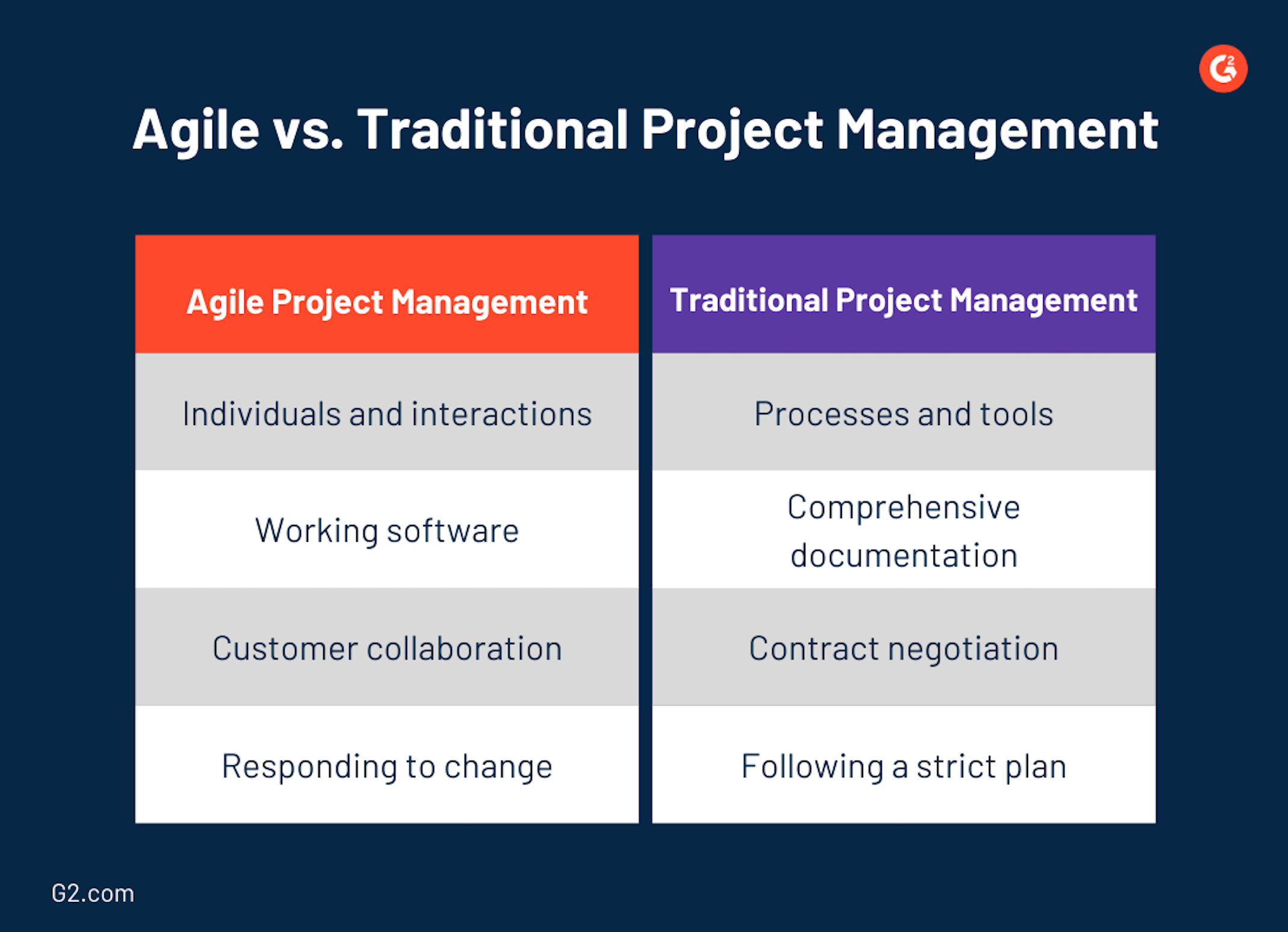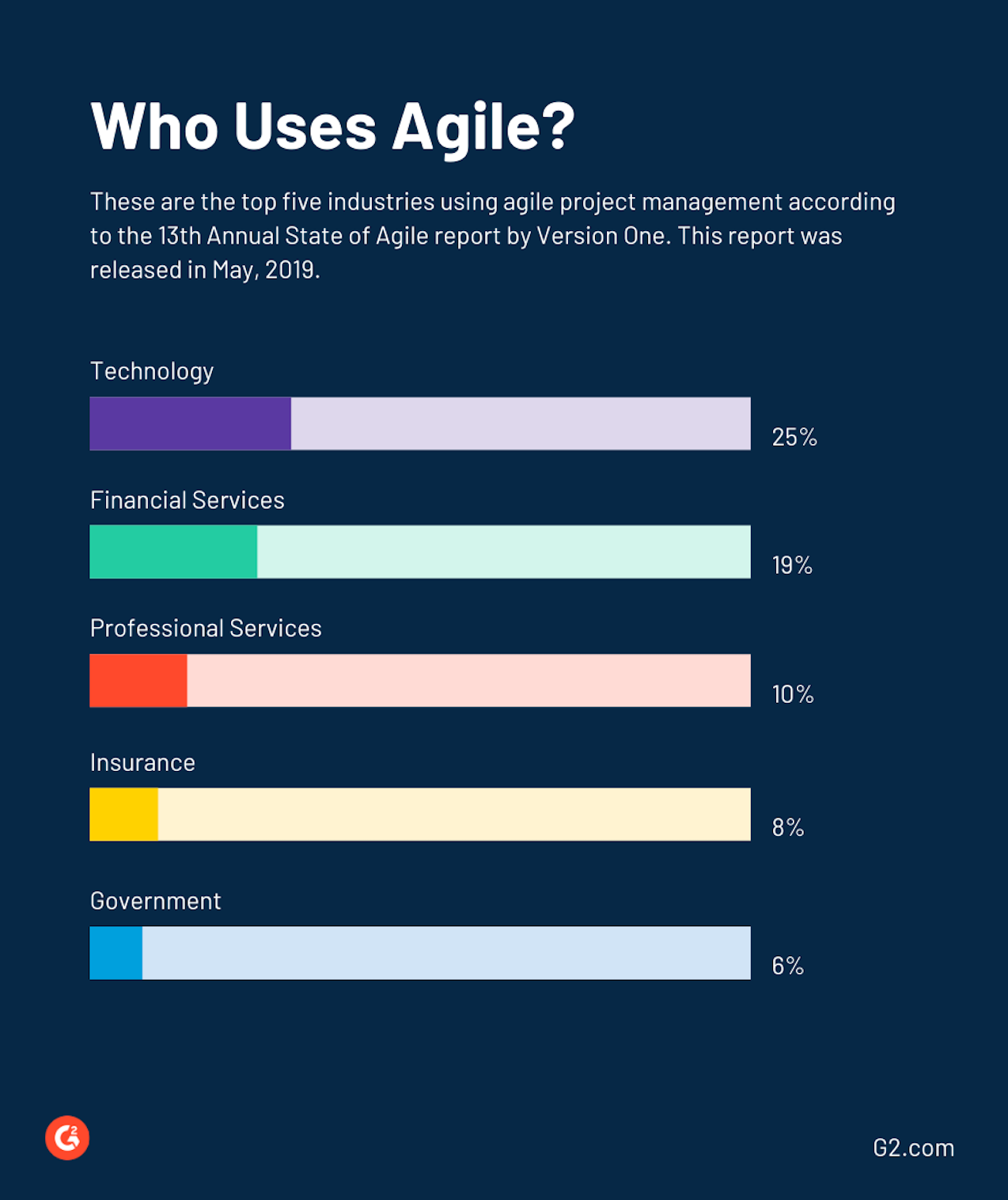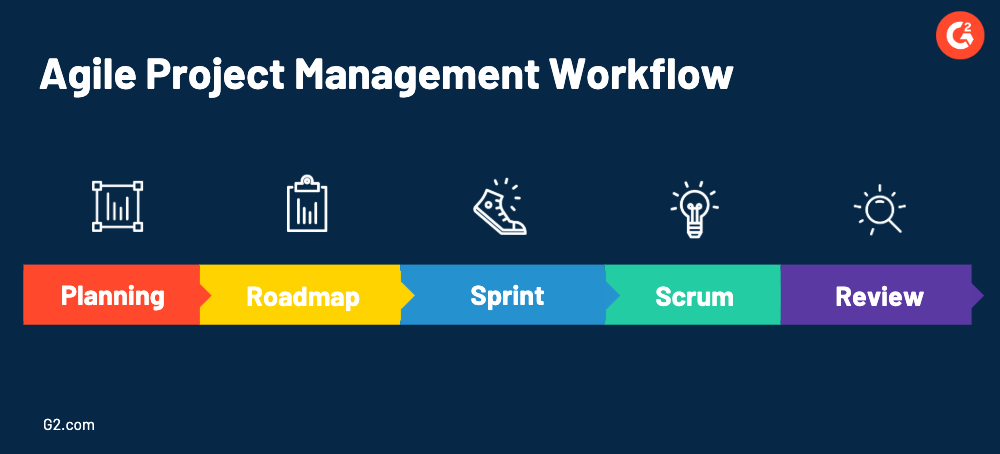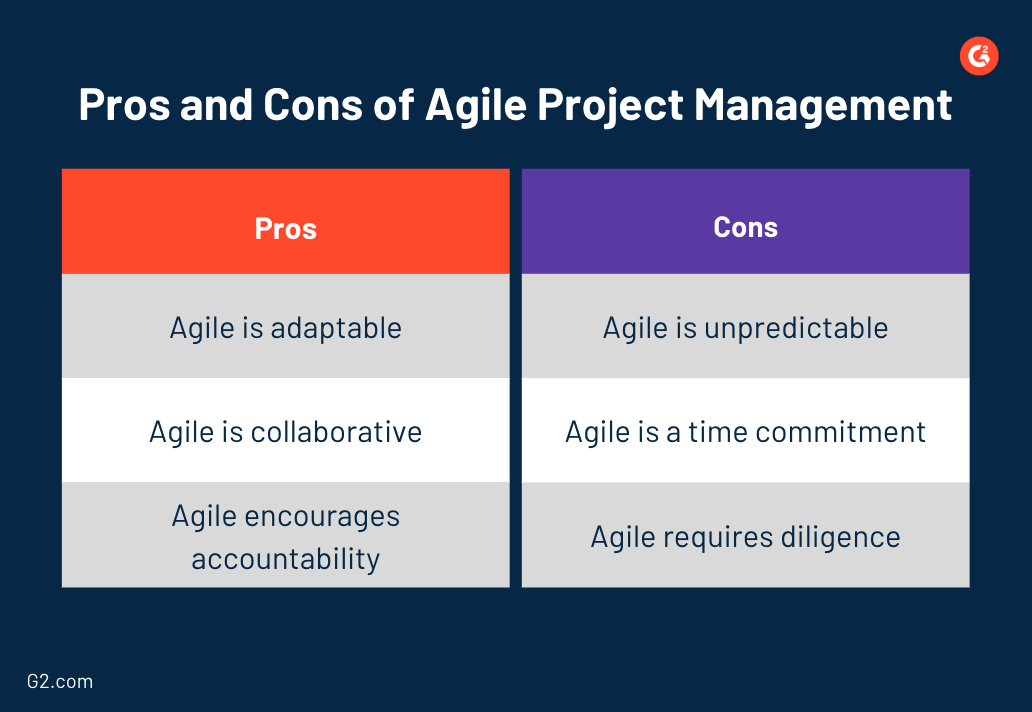Se necesita un equipo completo lleno de individuos talentosos para completar un proyecto. Pero incluso tus empleados más talentosos necesitan dirección para guiarlos hacia el éxito.
Para la mayoría de las empresas, esa dirección viene en forma de gestión de proyectos. Hay innumerables estrategias de gestión de proyectos que tu equipo puede usar para hacer el trabajo. Dependiendo del tamaño y nivel de experiencia de tu equipo, una estrategia podría ser mejor que otra.
Sin embargo, si estás buscando específicamente una estrategia de gestión de proyectos para tu desarrollo de productos, no busques más allá de la gestión de proyectos ágil.
¿Qué es el proceso de gestión de proyectos ágil?
La gestión de proyectos ágil es una estrategia de gestión de proyectos que se centra en la colaboración, la velocidad y la flexibilidad. Está diseñada para que los equipos puedan desarrollar características del producto a un ritmo acelerado, mientras entregan el producto de la más alta calidad.
Ágil es la intersección de la velocidad y la calidad. Permite a tu equipo centrarse en el trabajo en lugar del proceso. Con ágil, no te preocupas tanto por cómo se hace el trabajo, sino por si se hace correctamente. Producir un producto de calidad es la parte más importante de ágil.
Ágil es una estrategia de gestión de proyectos utilizada para dividir grandes proyectos en secciones más pequeñas entregables conocidas como características. Ágil se utiliza comúnmente junto con el desarrollo de productos. El término gestión de proyectos ágil se refiere a la naturaleza rápida de estos sprints que permiten a tu equipo cambiar de dirección durante un proyecto según sea necesario.
La gestión de proyectos ágil se centra en un ciclo de retroalimentación constante. Permite a los equipos pivotar rápidamente basándose en actualizaciones diarias. Es menos rígida que otras metodologías de gestión de proyectos y abre el espacio para la comunicación y colaboración abierta.

Cuando adoptas la estrategia de gestión de proyectos ágil, estás desechando la idea de una planificación rígida. Para implementar ágil con éxito, debes estar de acuerdo con el constante flujo y reflujo de un proyecto. Estos cambios y ajustes no son señales de que un proyecto va mal, son señales de que el proyecto está evolucionando hacia la mejor versión que puede ser.
¿Qué industrias utilizan la gestión de proyectos ágil?
Según el 13º Informe Anual del Estado de Ágil de Version One, la tecnología no es la única industria que está utilizando la gestión de proyectos ágil.
¿Interesado en qué industrias están adoptando la gestión de proyectos ágil? Aquí están las cinco principales industrias que utilizan la gestión de proyectos ágil hasta la fecha.

Aunque algunos de esos porcentajes pueden parecer bajos al principio, es importante notar que el 90% de los encuestados en ese mismo estudio afirman que la transformación DevOps fue crucial para el éxito de su organización. Se espera que estos números sigan aumentando a medida que más equipos adopten el marco ágil para sus propias organizaciones.
¿Quieres aprender más sobre Software de gestión de proyectos? Explora los productos de Gestión de Proyectos.
Terminología ágil
La gestión de proyectos ágil tiene su propio lenguaje que necesitarás aprender. Ya sea investigando las mejores prácticas ágiles o simplemente comunicándote con tu propio equipo, estas frases clave son importantes de conocer. Aquí tienes un vistazo a algunas terminologías ágiles populares:
Costo Real del Trabajo Realizado (ACWP) – ACWP mide el costo real del trabajo realizado en comparación con lo que se presupuestó previamente.
Costo Presupuestado del Trabajo Realizado (BCWP) – BCWP es el costo previsto del trabajo realizado antes de que comience el proyecto. Este número probablemente cambiará a medida que el proyecto avance.
Diagrama de Gantt – Un diagrama de Gantt es una herramienta de programación utilizada por los gestores de proyectos para visualizar los hitos y plazos de un proyecto específico.
Kanban – Kanban es una herramienta de visualización de proyectos que un equipo utiliza con notas adhesivas en una pizarra para rastrear el progreso de su sprint o proyecto. Generalmente se separan en tres columnas: por hacer, en progreso y completado.
Desviación del Alcance – La desviación del alcance se refiere al peligro de que tu proyecto se expanda lentamente fuera del alcance original del proyecto. Esto puede referirse a plazos extendidos, costos exorbitantes y entregables adicionales.
Scrum – Scrum es una versión popular de la metodología ágil que se centra en entregar un producto en el menor tiempo posible. Scrum se centra más en que el equipo de producto se autoorganice en lugar de ser dirigido por un gestor de proyectos. Esta versión de ágil es mejor utilizada por un equipo de producto con años de experiencia y liderazgo a sus espaldas.
Triple Restricción – La triple restricción se refiere a la relación entre el costo de tu proyecto, el alcance del proyecto y el cronograma del proyecto. Si una de estas tres cosas cambia, las otras dos variables deben ajustarse también.
Estructura de Desglose del Trabajo (WBS) – WBS es una estructura de desglose de proyectos que divide un proyecto más grande en piezas más pequeñas y manejables. En la gestión de proyectos ágil, estas secciones más pequeñas de trabajo se conocen como una característica.
Metodología de gestión de proyectos ágil
Como se mencionó anteriormente, la base de la metodología ágil se extrae del Manifiesto Ágil. Los principios de la gestión de proyectos ágil tal como los conocemos hoy no han cambiado mucho desde que se escribió el manifiesto y se pueden dividir en dos enfoques principales: los cuatro valores fundamentales de ágil y los 12 principios de ágil.
¿Cuáles son los cuatro valores fundamentales de ágil?
Los valores fundamentales de la gestión de proyectos ágil son los principios rectores de ágil. Cualquier equipo que adopte este método debe seguirlos. Si te encuentras en desacuerdo con alguno de los valores fundamentales de ágil, entonces una estrategia de gestión de proyectos diferente podría ser mejor para ti.
1. Individuos e interacciones sobre procesos y herramientas
El primer valor de la metodología ágil es las personas sobre el proceso. Esto significa que das prioridad a tus compañeros de equipo y empleados sobre los flujos de trabajo. Esto es importante porque la comunicación y la adaptabilidad están en el núcleo de ágil.
Si interrumpes el trabajo de tus empleados y desacreditas sus preocupaciones por el bien de los flujos de trabajo, descarrilarás el proceso. También perderás la confianza de tu equipo. Serán menos propensos a sugerir mejoras o ideas y, como resultado final, tu producto sufrirá.
2. Software funcional sobre documentación exhaustiva
El segundo valor de ágil es el producto final sobre el proceso. Con demasiada frecuencia, los gestores de proyectos se obsesionan con su necesidad de documentar cada parte del proceso. Esto ralentiza a tu equipo y retrasa el lanzamiento de tu producto.
Si bien la documentación es importante, este valor enfatiza la importancia de documentar solo lo absolutamente necesario. Eso significa eliminar formularios inútiles o hojas de cálculo duplicadas y, en su lugar, permitir que tu equipo dedique su tiempo a trabajar en el producto.
3. Colaboración con el cliente sobre negociación de contratos
El tercer valor de la gestión de proyectos ágil se centra en la colaboración. Con demasiada frecuencia, negociamos contratos con el cliente y luego los excluimos del proceso hasta que el producto final está terminado. Ágil anima al cliente a ser parte del proceso en cada etapa.
Esto puede ser intimidante de manejar, especialmente si tienes miedo de mostrar al cliente cómo se hace el trabajo. Pero permitir que el cliente sea parte tanto de tus éxitos como de tus fracasos a lo largo del camino hace que el producto sea mejor. No habrá duda de si has entregado lo que el cliente quiere al final, porque han sido parte de la producción desde el principio.
4. Responder al cambio sobre seguir un plan
El valor final de ágil es dar la bienvenida al cambio sobre seguir el plan. Esto debería ser lo suficientemente fácil de entender. A veces el plan simplemente está equivocado. Puede ser fácil ver por qué ser flexible sería importante en una situación como esa. Pero este valor fundamental también significa cuestionar el plan incluso cuando va bien.
Con ágil, no hay excusa para seguir adelante con el plan porque funciona lo suficientemente bien para hacer el trabajo. No hay lugar para la mediocridad. Ágil te obliga a ti y a tu equipo a preguntar si algo que ya está funcionando bien puede funcionar mejor y luego cambiarlo, independientemente del plan.
¿Cuáles son los 12 principios de ágil?
Si los cuatro valores fundamentales de ágil responden al por qué, los principios de ágil responden al cómo. Es una cosa decir que vas a ser más ágil, es otra cosa hacerlo. El Manifiesto Ágil describe doce cosas en las que debes centrarte para optimizar la metodología ágil.
1. Satisfacción del cliente
Entregar un producto con el que el cliente esté satisfecho es la prioridad número uno para cualquier equipo de gestión de proyectos. Esto se logra entregando características temprano y con frecuencia. Los clientes quieren estar involucrados en el proceso y prefieren recibir trabajo a intervalos regulares, en lugar de esperar meses entre lanzamientos.
2. Dar la bienvenida al cambio
Esto es más que solo colaboración. La metodología ágil se trata de crear el mejor producto posible. Cuando te resistes a las sugerencias y cambios, hace que todo el proceso se detenga. Estos retrasos resultarán en plazos incumplidos y un cliente frustrado. Puedes evitar estos problemas siendo abierto y receptivo al cambio.
3. Entregar con frecuencia
La gestión de proyectos ágil se define por sus sprints cortos conocidos como características. El proceso está diseñado para permitir que tu equipo entregue piezas del proyecto con más frecuencia. Cuando entregas proyectos en piezas más pequeñas y manejables, permite que la retroalimentación y los cambios se realicen más rápidamente.
4. Trabajar juntos
Los mejores productos del mercado tienen una cosa en común: fueron diseñados a través del trabajo en equipo. Trabajar en un silo frena la creatividad y la colaboración. Tú y tu equipo deberían reunirse entre sí diariamente o semanalmente. Esto fomenta discusiones abiertas y sinceras que impulsarán a tu producto a ser mejor.

5. Equipos motivados
No es un secreto que las personas motivadas producen mejor trabajo. Crear un ambiente donde tus empleados se sientan alentados a dar lo mejor de sí se traducirá en tu producto. Esto significa encontrar qué motiva a tus empleados y luego dárselo. También significa entender que no todos están motivados por lo mismo.
6. Interacciones cara a cara
Hemos mencionado la importancia de reunirse con tu equipo regularmente, pero no hemos tocado la importancia de que estas reuniones sean cara a cara. Evita tener estas conversaciones importantes por correo electrónico. Reunirse en persona reduce las posibilidades de que las cosas se pierdan en la traducción y mantiene a tu equipo más comprometido. Cuando sea posible, deberías reunirte en persona para discutir tus ideas.
¿Tienes problemas para reunir a todos en la misma sala? El software de videoconferencia puede ayudarte a reunir a tu equipo en un solo lugar para reuniones cara a cara.
7. Software funcional
Esto puede sonar obvio, pero el producto necesita funcionar. No solo necesita funcionar correctamente, sino que también debe poder realizar las tareas que el cliente desea. El software funcional significa que un producto funciona sin errores o fallos del sistema.
8. Ritmo constante
Sabrás que tu equipo ha dominado la gestión de proyectos ágil cuando puedas mantener un ritmo constante y repetible. Tu equipo debería familiarizarse lo suficiente con sus flujos de trabajo para que tú, como gestor de proyectos, hagas menos gestión diaria y más cosas de visión general. Esto te permite producir productos de calidad en un cronograma confiable y rápido, sin agotamiento de los empleados.
9. Buen diseño
El diseño es más que cómo se ve tu producto. La funcionalidad del producto y la experiencia del usuario son igual de importantes, si no más, que los aspectos visuales. Tu equipo debería estar probando el diseño de tu producto junto con todos los demás aspectos del producto. Nada es peor que un producto que se lanza con una interfaz de usuario deficiente o un diseño torpe.
10. Simplicidad
Tomaremos nuestro propio consejo en esta sección: manténlo simple, estúpido. Solo haz lo que sea absolutamente necesario para entregar tu proyecto a tiempo y con la más alta calidad.
11. Autoorganización
Un equipo que puede autoorganizarse es crítico para la gestión de proyectos ágil. Tus empleados deben poder tomar decisiones, asumir la responsabilidad de sus ideas y comunicarse con otros miembros del equipo por su cuenta. Esto ayuda a impulsar el proceso hacia adelante y previene bloqueos. También hace que el producto sea mejor en general.
12. Reflexionar y ajustar
La gestión de proyectos ágil pone un gran énfasis en hacer cambios rápidos. A veces no todos los cambios que decides hacer funcionarán, y por eso es importante reflexionar sobre el proceso regularmente. Cuando te tomas el tiempo para registrarte con tu equipo y recalibrar, las cosas funcionan mejor y los procesos mejoran.
Implementación de la gestión de proyectos ágil
Todos estos elementos fundamentales son inútiles sin un plan para ponerlos en acción. La gestión de proyectos ágil debe adaptarse a tu equipo individual, sin embargo, hay algunos conceptos básicos que puedes usar para comenzar. Aquí tienes un vistazo rápido a cómo podría ser ese proceso:

Hay docenas de partes móviles para cada sección que requieren atención cuidadosa al detalle. Vamos a profundizar en cada parte del proceso y aprender más. Cuanto más entiendas, mejor podrás crear un proceso ágil que funcione para tu equipo.
Planificación del proyecto
El primer paso para la gestión de proyectos ágil es diseñar tu plan de proyecto. Un plan de proyecto está diseñado para mapear todo sobre un proyecto, desde qué entregables se necesitan, hasta el costo y más. La planificación de proyectos para la metodología ágil es diferente de lo que probablemente estás acostumbrado.
Cuando creas un plan de proyecto para ágil, lo haces con el entendimiento de que tu plan de proyecto cambiará y evolucionará con el tiempo. Los planes de proyecto ágiles no son tan rígidos. Están diseñados con el conocimiento de que las cosas cambiarán y tu equipo trabajará para ajustarse según sea necesario
La mayoría de los equipos utilizarán software de gestión de proyectos en esta fase de su planificación. El software de gestión de proyectos te permite delegar tareas dentro de los proyectos, establecer objetivos y crear cronogramas de proyectos para que tu equipo los siga.
Encuentra el mejor software de gestión de proyectos en el mercado basado en reseñas reales de usuarios como tú.
Creación de la hoja de ruta del producto
Una vez que hayas planificado el proyecto, es hora de crear tu hoja de ruta. Una hoja de ruta del producto describe todo lo que necesita suceder para llevar a tu equipo de una idea al producto final. En la gestión de proyectos ágil, deberías limitar tu hoja de ruta del producto solo a lo esencial.
Aquí hay algunas preguntas que deberías hacerte al crear una hoja de ruta del producto:
- ¿Cuánto tiempo tomará completar completamente este proyecto?
- ¿Cuánto tiempo deberíamos planificar entre lanzamientos?
- ¿Hay algún problema con el que podríamos encontrarnos?
- ¿Cómo se ve el éxito para este producto?
- ¿Cómo estamos documentando este proceso?
Nuevamente, la clave de todo esto es ser flexible. Tu hoja de ruta podría cambiar en el camino y eso está bien. Ser ágil significa ser adaptable.
Planificación de sprints
La planificación de sprints es un concepto tomado de Scrum. Scrum es una metodología de gestión de proyectos que divide el trabajo de grandes proyectos en sprints más pequeños. Estos sprints están diseñados para facilitar el lanzamiento de cada característica. Tu sprint es un período de tiempo establecido donde se realiza todo el trabajo para un lanzamiento específico.
Al final de cada sprint, tu equipo entregará la nueva característica al cliente. Una vez que eso esté completo, tu equipo comenzará a planificar y trabajar en su próximo sprint. Este ciclo continúa hasta que el proyecto esté completo.
La mayoría de los equipos establecen sus sprints para que duren aproximadamente dos semanas cada uno. Cualquier cosa más larga que cuatro semanas y tu marco de tiempo ya no se considera un sprint. Es importante mantener tus sprints cortos porque permite que tu equipo trabaje rápidamente sin agotarse.
Reuniones diarias de scrum
Una vez que hayas establecido tus sprints, querrás fijar un horario en el que tu equipo pueda reunirse todos los días. Recuerda, tu sprint probablemente solo durará dos semanas. Eso significa que hay muy poco tiempo para malentendidos. Las reuniones diarias son vitales para el éxito de tu equipo. Te permiten ventilar cualquier problema que hayas encontrado, ajustarte en consecuencia y seguir avanzando.
Revisión y retrospectiva del sprint
Una vez que tu equipo complete tu sprint, es hora de hacer un resumen. Siéntate con tu equipo y habla sobre lo que funcionó y lo que no. Permite que todos en tu equipo hablen sobre sus éxitos y frustraciones con el último sprint y luego crea un plan para solucionar esas cosas en el futuro. Las revisiones de sprint son importantes porque te permiten afinar tu proceso con el tiempo. Eventualmente, usarás estas reuniones para hablar sobre cosas de visión general en lugar de inconvenientes menores.
Roles en la gestión de proyectos ágil
Si nunca has construido un equipo de gestión de proyectos ágil antes, podrías no estar familiarizado con quiénes deberían ser tus jugadores clave. Aquí hay algunos roles que necesitarás llenar para planificar sprints, ejecutar el diseño del producto y más.
Gerente de producto
Los gerentes de producto son estrategas. Tu gerente de producto es la persona en tu equipo que aboga por tu producto fuera de tu empresa. Encabezan la investigación de mercado para tu producto y se comunican directamente con los clientes sobre establecer el presupuesto y el alcance del proyecto. Tu gerente de producto es la persona que más sabe sobre el cliente ideal para tu producto.
Propietario del producto
Los propietarios del producto son tecnólogos. Ellos poseen el proceso de implementación y gestionan el trabajo diario del equipo de desarrollo. El propietario del producto toma la estrategia diseñada por el gerente de producto y la convierte en un plan de acción para el resto del equipo. Ayudan a coordinar los scrums diarios, planificar sprints y convertir el plan más grande en una realidad.
Miembros del equipo de desarrollo
Los miembros del equipo de desarrollo son las personas que construyen tu producto. Estos son tus ingenieros de software, tus científicos de datos y desarrolladores de sitios web. Es importante tener diversidad de roles en tu equipo de desarrollo porque cada miembro del equipo aporta una nueva perspectiva a tu equipo. Si tienes siete desarrolladores de software y cero redactores, tu equipo sufrirá por ello. ¡Llena tu equipo con diferentes talentos!
Scrum master
El scrum master es el gestor de proyectos. Son la persona encargada de mantener todo en movimiento. Cuando surgen problemas en el proyecto o algo sale mal durante el proceso de sprint, el scrum master es el encargado de solucionar cualquier problema. Los scrum masters son más efectivos cuando tienen cierta autoridad formal dentro de su organización porque pueden influir más fácilmente en el cambio.
Habilidades de un miembro del equipo ágil
Construir tu equipo se trata de más que títulos de trabajo, necesitas el conjunto adecuado de habilidades para impulsar tu estrategia ágil hacia adelante. Se necesita la combinación adecuada de habilidades duras y blandas para un equipo ágil. Además del conocimiento típico de codificación o software que necesitará tu equipo de desarrollo, la experiencia en comunicación y liderazgo también es importante.
Aquí hay algunas de las habilidades más importantes para un equipo ágil:
- Adaptabilidad
- Responsabilidad
- Comunicación
- Curiosidad
- Multifuncionalidad
- Liderazgo
- Autonomía
- Orientación al equipo
La mayoría de estas habilidades se pueden enseñar o entrenar en el trabajo. Contrata por habilidades duras y luego crea un ambiente que valore el liderazgo y la comunicación. Muestra a tu equipo cómo se ve el éxito a través del liderazgo con el ejemplo.
Certificación en gestión de proyectos
No solo tu equipo puede beneficiarse de mejorar sus habilidades. Cuanto más seguro te sientas en tu capacidad como gestor de proyectos, más confianza tendrá tu equipo en ti. Una forma de centrarte en tus propias habilidades es completando una certificación en gestión de proyectos.
Hay dos certificaciones populares en gestión de proyectos que puedes elegir: el CAPM y el PMP.
La certificación CAPM
La certificación CAPM es perfecta para alguien que recién comienza en su carrera de gestión de proyectos. Para calificar para el CAPM, necesitarás tener un mínimo de 1,500 horas de experiencia laboral, que son aproximadamente 10 meses en un rol de tiempo completo, y un diploma de escuela secundaria o un título de asociado. Una vez que alcances esas calificaciones, solo necesitarás completar cualquier curso requerido y aprobar el examen.
La certificación PMP
La certificación PMP requiere que tengas un poco más de experiencia que la certificación CAPM. Hay dos caminos para calificar para una certificación PMP y ambos requieren 35 horas de educación adicional.
El primer requisito previo requiere que tengas 4,500 horas de trabajo, que es un poco más de dos años de experiencia, un título de cuatro años y las 35 horas de capacitación.
El segundo requisito previo requiere cualquier título secundario, al menos 7,500 horas de experiencia, que son aproximadamente cuatro años en el trabajo, y las 35 horas de capacitación adicionales.
La conclusión: Siempre es mejor mirar qué programa de certificación estás más cerca de calificar antes de decidir y luego elegir cuál seguir. Esto acorta la cantidad de tiempo que necesitas dedicar a completar tu certificación.
Pros y contras de la gestión de proyectos ágil
La metodología ágil es solo una de las muchas metodologías de gestión de proyectos que tu equipo puede implementar. Antes de determinar si la gestión de proyectos ágil es adecuada para tu equipo, necesitarás entender los beneficios y desventajas.
Aquí tienes un vistazo rápido a los pros y contras de cambiar a ágil:

Recuerda, solo porque ágil es un método de gestión de proyectos popular no significa que será adecuado para tu equipo. Echemos un vistazo más de cerca a los pros y contras detallados de usar la gestión de proyectos ágil.
Pros de la gestión de proyectos ágil
La metodología ágil es conocida por su ritmo rápido y flexibilidad. Si tu equipo es del tipo que piensa rápido y disfruta de un desafío, ¡entonces ágil podría ser adecuado para ti! Hay tres beneficios principales de adoptar una mentalidad ágil para tu próximo lanzamiento de producto.
Ágil es adaptable
Una de las mayores atracciones de la metodología ágil es lo rápido que permite a tu equipo adaptarse. El ciclo de retroalimentación constante te permite, como gestor de proyectos, detectar problemas temprano y solucionarlos. También te ayuda a registrarte con frecuencia con los miembros del equipo para asegurarte de que todos estén trabajando hacia el mismo objetivo.
Ágil es colaborativo
Otro beneficio de la gestión de proyectos ágil es el enfoque en la colaboración. Ya sea que te reúnas diariamente o semanalmente, estas interacciones cara a cara animan a tu equipo a hablar entre sí más regularmente.
Esto es especialmente útil si tu proyecto involucra múltiples departamentos o partes interesadas. Al fomentar la comunicación constante, es menos probable que aísles tu trabajo de una manera que podría causar problemas más adelante.
Ágil fomenta la responsabilidad
Al dividir el trabajo de cada empleado en características más pequeñas, los animas a convertirse en sus propios mini-gestores de proyectos. Ágil permite a tus empleados la autonomía para tomar decisiones, llegar a conclusiones y desafiar los procesos existentes de manera constructiva.
Cuando cada empleado es responsable de su trabajo en un entorno estructurado y colaborativo, es probable que veas que la calidad de su trabajo mejora. Esto te permite hacer menos gestión de empleados y más gestión del proyecto en sí.
Contras de la gestión de proyectos ágil
Por supuesto, siempre hay desventajas junto con los beneficios. La gestión de proyectos ágil hace que sea más difícil planificar proyectos a largo plazo, así como también demanda más tiempo de tu equipo. Es importante sopesar tanto los pros como los contras.
Ágil es impredecible
La naturaleza de cambio rápido de la gestión de proyectos ágil hace que el proceso sea menos predecible. Si bien la capacidad de cambiar de rumbo para hacer un mejor producto es una ventaja, significa que tu equipo necesita estar preparado para que cualquier cosa cambie. Planificar semanas o incluso meses por adelantado para un proyecto es imposible con una estrategia de gestión de proyectos ágil.
Ágil toma tiempo
El aumento de la comunicación, las reuniones con los clientes y las reuniones diarias de scrum conducen a una cosa: más tiempo. Todas las cosas necesarias para que la gestión de proyectos ágil funcione sin problemas requieren un compromiso de tiempo significativo de ti y tu equipo. Eso también significa que todos en tu equipo deben comprometerse a presentarse cada vez y prestar toda su atención.
Ágil requiere diligencia
Cuando los proyectos cambian tan rápidamente como lo hacen en ágil, puede ser fácil olvidar qué viene después. Si no estás utilizando un software de gestión de proyectos para rastrear los cambios, tu equipo podría perder fácilmente de vista el siguiente paso. Tu trabajo como gestor de proyectos es asegurarte de que tu proyecto se mantenga en el camino durante la velocidad de cambio rápido que requiere la gestión de proyectos ágil.
Mueve más rápido con la gestión de proyectos ágil
Es importante notar que ágil solo funciona si estás dispuesto a seguir las reglas. No puedes adoptar ágil y luego negarte a ser flexible. Puede ser difícil hacer ajustes al principio, pero si puedes cambiar tu mentalidad, tú y tu equipo lograrán cosas increíbles.
¿Interesado en aprender sobre un proceso de gestión de proyectos diferente? Aquí tienes todo lo que necesitas saber sobre la metodología en cascada.

Lauren Pope
Lauren Pope is a former content marketer at G2. You can find her work featured on CNBC, Yahoo! Finance, the G2 Learning Hub, and other sites. In her free time, Lauren enjoys watching true crime shows and singing karaoke. (she/her/hers)
